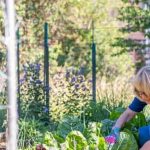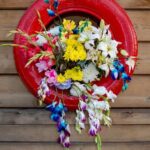Wild gardens are a delightful fusion of natural beauty and ecological significance, showcasing a diverse array of plants and vegetables in a biodiverse setting. These gardens are not only visually appealing but also play a crucial role in promoting biodiversity and ecosystem health. By embracing the concept of wild gardens, individuals can contribute to conservation efforts and create sustainable habitats for wildlife.
The importance of wild gardens lies in their ability to attract beneficial insects, such as pollinators like bees and butterflies, which are essential for plant reproduction. Additionally, these gardens provide food sources and shelter for a variety of wildlife, contributing to overall ecosystem resilience. By incorporating native plants and vegetables into wild garden spaces, individuals can create thriving ecosystems that support a wide range of species.
While designing a wild garden may seem daunting, selecting the right plants based on their suitability for biodiverse environments is key. By choosing native species that are adapted to local conditions, gardeners can ensure the long-term success of their wild garden. Furthermore, incorporating diagrams and layout ideas can help visualize and implement an aesthetically pleasing and functional design that enhances biodiversity within the space.
Benefits of Wild Gardens
Wild gardens play a crucial role in promoting biodiversity by creating a habitat where various plant and animal species can thrive. One of the key benefits of wild gardens is their ability to attract beneficial insects such as bees, butterflies, and ladybugs.
These insects are essential for pollination, which is vital for the reproduction of many plants, including vegetables. By providing a diverse range of nectar-rich flowers, wild gardens create a welcoming environment for these pollinators, helping to ensure the success of crops and native plants alike.
In addition to attracting beneficial insects, wild gardens also help improve overall ecosystem health. The diverse array of plants in a wild garden creates a more balanced and resilient ecosystem by providing food and shelter for a wide variety of wildlife.
This, in turn, contributes to the natural control of pests and diseases, reducing the need for chemical interventions that can harm both the environment and human health. By supporting a healthy ecosystem, wild gardens act as a sustainable and eco-friendly gardening option that benefits not only plants but also the entire ecosystem.
When choosing plants for your wild garden, opt for native species that are well-suited to your region’s climate and soil conditions. Native plants have adapted over time to thrive in their natural habitats, making them low-maintenance choices that require minimal watering and fertilization.
Some examples of native plants that are excellent additions to wild gardens include milkweed for attracting monarch butterflies, coneflowers for attracting bees, and native grasses for providing cover and nesting sites for birds. Incorporating a variety of these plants into your wild garden will help create a diverse and vibrant ecosystem that supports both plant and animal life.
- Milkweed
- Coneflowers
- Native grasses
By cultivating a bio diverse environment through the thoughtful selection of plants in your wild garden, you are not only creating an aesthetically pleasing space but also contributing to the preservation of local ecosystems. Embrace the beauty of diversity in nature by incorporating a variety of native plants into your wild garden design.
Choosing Plants for Wild Gardens
When creating a wild garden, choosing the right plants is key to promoting biodiversity and creating a thriving ecosystem. Native plants are essential for attracting beneficial insects, pollinators, and other wildlife that contribute to the health of your garden. These plants have evolved with the local environment and provide food and habitat for a variety of species. When selecting plants for your wild garden, consider not only their beauty but also their ecological value.
Native Plants for Wild Gardens
One excellent choice for a wild garden is the Purple Coneflower (Echinacea purpurea), known for its beautiful purple blooms and its attractiveness to bees and butterflies. Another native plant to consider is the Black-eyed Susan (Rudbeckia hirta), which provides seeds for birds and nectar for pollinators.
For vegetable options in bio diverse environments, consider planting heirloom varieties such as Cherokee Purple tomatoes or Jimmy Nardello’s Sweet Italian frying peppers. By incorporating these native plants and vegetables into your wild garden, you can create a diverse and sustainable ecosystem.
Creating Habitat Diversity
In addition to selecting native plants, it’s important to create different habitats within your wild garden to support a wide range of species. Include tall grasses or shrubs for nesting birds, as well as flowering plants for pollinators.
Adding water features like a small pond or bird bath can attract amphibians and birds while providing drinking water for wildlife. By designing your wild garden with a variety of habitats in mind, you can maximize its potential as a biodiverse haven.
Maintaining Balance
While it’s tempting to let nature take its course in a wild garden, some maintenance is necessary to ensure the health of your plants and promote biodiversity. Regular weeding helps prevent invasive species from taking over and competing with native plants.
Watering during dry spells can help newly established vegetation thrive, while natural pest control methods like introducing beneficial insects can keep pests at bay without harming the ecosystem. By striking a balance between intervention and letting nature run its course, you can enjoy a vibrant and sustainable wild garden full of life.
Designing Your Wild Garden
Creating a visually appealing and functional wild garden requires thoughtful planning and design to maximize the benefits of biodiversity. By incorporating diverse plant species, strategic layouts, and habitat features, you can create a vibrant ecosystem in your own backyard. Here are some tips on designing your wild garden:
- Start by researching native plants that are suitable for wild gardens in your area. These plants are adapted to the local climate and soil conditions, making them more resilient and attractive to beneficial insects.
- Consider the layout of your wild garden, taking into account factors such as sunlight exposure, water availability, and existing structures. Use diagrams to plan out different zones within your garden, such as a pollinator bed or a vegetable patch.
- Integrate habitat features like bird feeders, bee hotels, or butterfly puddling stations to attract wildlife to your garden. By creating diverse habitats, you can support a wide range of species and promote ecological balance.
Incorporating elements of permaculture design principles can also enhance the functionality of your wild garden. For example, companion planting techniques can help deter pests and improve overall plant health. Additionally, using mulch and composting methods can enrich the soil and reduce the need for chemical fertilizers.
By following these tips and utilizing diagrams to visualize your design ideas, you can create a beautiful and bio diverse wild garden that not only enhances the aesthetic appeal of your outdoor space but also contributes to the conservation of local ecosystems.
Remember that maintenance is key to ensuring the long-term success of your wild garden. Regular watering, mulching, weeding, and monitoring for pest infestations are essential tasks to keep your garden thriving. By staying attentive to the needs of your plants and wildlife visitors, you can create a sustainable haven for biodiversity right in your own backyard.
Maintaining a Wild Garden
Once you have established your wild garden, it is essential to maintain it properly to ensure its longevity and effectiveness in promoting biodiversity. One of the key aspects of maintaining a wild garden is the appropriate watering regimen. Unlike traditional gardens, wild gardens typically require less water as they are designed to mimic natural ecosystems. Watering should be done sparingly, especially during periods of rainfall scarcity, to allow the plants to adapt and develop deep root systems.
Weeding is another crucial aspect of wild garden maintenance. While some weeds can be beneficial for wildlife, invasive species can outcompete native plants and disrupt the balance of the ecosystem. Regular weeding sessions are recommended to remove any unwanted vegetation and create space for your chosen wild garden plants to thrive. It is important to use environmentally friendly weeding methods, such as hand pulling or mulching, to minimize disturbance to the soil and surrounding wildlife.
Pest control in a wild garden should be approached with caution, as many chemical pesticides can harm beneficial insects and other wildlife that contribute to biodiversity. Integrated pest management (IPM) techniques are preferred in wild gardens, which involve using a combination of cultural practices, biological controls, and natural predators to manage pests effectively. By creating a balanced ecosystem within your wild garden, you can reduce the need for chemical interventions and maintain a healthy environment for both plants and animals.
| Aspect of Maintenance | Best Practices |
|---|---|
| Watering | Water sparingly; mimic natural rainfall patterns; encourage deep root growth |
| Weeding | Regularly remove invasive species; use eco-friendly methods like hand pulling or mulching |
| Pest Control | Adopt integrated pest management techniques; avoid chemical pesticides; promote natural predators |
Attracting Wildlife
Wild gardens are not only a delight to the eyes but also serve as havens for various forms of wildlife, playing a crucial role in sustaining biodiversity. By carefully selecting plants that provide food and shelter for birds, butterflies, bees, and other creatures, you can transform your wild garden into a thriving ecosystem. Native plants are particularly beneficial as they have evolved alongside local wildlife and provide essential resources for their survival.
When it comes to attracting birds to your wild garden, consider planting a variety of shrubs and trees that offer berries or seeds as a food source. Species such as elderberry, serviceberry, and sunflowers are popular choices that can attract a diverse range of bird species throughout the year. Providing water sources like birdbaths or small ponds can also invite birds to visit and stay in your garden.
Butterflies add color and beauty to any wild garden, making them a sought-after guest for many gardeners. To attract these delicate insects, incorporate nectar-rich flowers such as butterfly bush, coneflowers, and milkweed into your planting scheme. Additionally, creating specific habitats like butterfly houses or leaving areas of bare ground for certain butterfly species to lay eggs can further enhance the appeal of your garden to these winged wonders.
| Wildlife Attraction | Recommended Plants |
|---|---|
| Birds | Elderberry, Serviceberry, Sunflowers |
| Butterflies | Butterfly Bush, Coneflowers, Milkweed |
Creating diverse habitats within your wild garden is key to attracting not just birds and butterflies but also other forms of wildlife like bees, frogs, and beneficial insects. Incorporating features such as log piles for insects to inhabit or native grasses for pollinators can increase the overall biodiversity of your garden. By focusing on plant selection and habitat creation in your wild garden design, you can establish a welcoming environment that supports a wide array of wildlife species.
Success Stories
Wild gardens have gained popularity in recent years due to their positive impact on the environment and promotion of biodiversity. These gardens are characterized by the use of native plants and vegetables that thrive in bio diverse environments, attracting a wide range of beneficial insects and wildlife. Success stories from wild gardeners around the world showcase the beauty and benefits of these natural spaces.
Community Wild Garden Project Transforms Urban Neighborhood
In a bustling urban neighborhood, a group of dedicated residents came together to transform a vacant lot into a thriving community wild garden. By choosing a variety of native plants and vegetables known for their ability to attract pollinators and other beneficial insects, they not only created a visually stunning landscape but also improved the overall ecosystem health in their area.
The once barren lot is now teeming with life, as birds, butterflies, and bees visit regularly to feed and nest.
Family-Owned Farm Embraces Wild Gardening for Sustainability
On a family-owned farm in rural countryside, the owners made the decision to incorporate wild gardens into their agricultural practices as a way to promote sustainability and biodiversity. By planting a mix of wildflowers, herbs, and vegetables known for their resilience and ability to support local wildlife populations, they have seen an increase in crop yields and reduced the need for chemical pesticides. The farm now serves as a model for sustainable agriculture practices in the region.
Resources for Wild Gardeners
In conclusion, wild gardens play a crucial role in promoting biodiversity and supporting healthy ecosystems. By choosing the right plants and vegetables for your wild garden, you can create a bio diverse haven that attracts beneficial insects, promotes pollination, and improves overall ecosystem health. Designing your wild garden with the help of diagrams and layout ideas can not only make it visually appealing but also functional in providing food and shelter for wildlife.
Maintaining a wild garden requires ongoing care such as watering, weeding, and pest control methods to ensure its success. By following best practices and staying dedicated to your garden, you can create a thriving habitat for birds, butterflies, and other wildlife. Additionally, sharing success stories of wild gardens can inspire others to join in the effort of promoting biodiversity conservation through wild gardening.
For those interested in learning more about wild gardening and biodiversity conservation, there are various resources available including books, websites, and organizations dedicated to this cause. These resources can provide valuable information on plant selection, habitat creation, and sustainable gardening practices. By utilizing these resources effectively, you can become a passionate advocate for wild gardens and contribute to the preservation of our environment.
Frequently Asked Questions
How Do Gardens Affect Biodiversity?
Gardens can have a significant impact on biodiversity by providing a habitat for various plant and animal species to thrive. They offer food, shelter, and breeding grounds for a diverse range of organisms, ultimately promoting the overall health of ecosystems.
What Plants Are Good for a Biodiverse Garden?
A biodiverse garden includes a variety of native plants that are well adapted to the local environment. Native plants attract native insects, birds, and other wildlife, creating a balanced ecosystem. Incorporating different types of plants such as trees, shrubs, flowers, and grasses can enhance biodiversity in the garden.
How Do Plants Contribute to Biodiversity?
Plants play a crucial role in supporting biodiversity by providing food and shelter for a wide range of organisms. They serve as the foundation of most ecosystems, influencing the abundance and diversity of other species within the environment. Plants also contribute to biodiversity by helping to regulate nutrient cycles, water balance, and soil structure.

If you’re looking to get into vegetable gardening, or are just looking for some tips on how to make your current garden better, then you’ve come to the right place! My name is Ethel and I have been gardening for years. In this blog, I’m going to share with you some of my best tips on how to create a successful vegetable garden.





